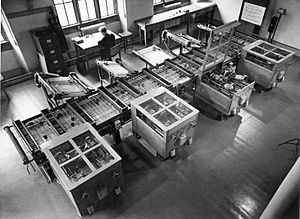Vannevar Bush facts for kids
Quick facts for kids
Vannevar Bush
|
|
|---|---|
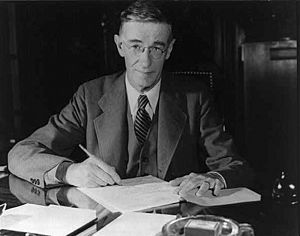 |
|
| Chairman of the Research and Development Board | |
| In office September 30, 1947 – October 14, 1948 |
|
| President | Harry S. Truman |
| Preceded by | Position established |
| Succeeded by | Karl Compton |
| Director of the Office of Scientific Research and Development | |
| In office June 28, 1941 – December 31, 1947 |
|
| President | Franklin D. Roosevelt Harry S. Truman |
| Preceded by | Position established |
| Succeeded by | Position abolished |
| Chairman of the National Defense Research Committee | |
| In office June 27, 1940 – June 28, 1941 |
|
| President | Franklin D. Roosevelt |
| Preceded by | Position established |
| Succeeded by | James B. Conant |
| Chairman of the National Advisory Committee for Aeronautics | |
| In office October 19, 1939 – June 28, 1941 |
|
| President | Franklin D. Roosevelt |
| Preceded by | Joseph Ames |
| Succeeded by | Jerome Hunsaker |
| Personal details | |
| Born | March 11, 1890 Everett, Massachusetts, U.S. |
| Died | June 28, 1974 (aged 84) Belmont, Massachusetts, U.S. |
| Education | Tufts College (BS, MS) Massachusetts Institute of Technology (DEng) |
| Awards | Edison Medal (1943) Hoover Medal (1946) Medal for Merit (1948) IRI Medal (1949) John Fritz Medal (1951) John J. Carty Award for the Advancement of Science (1953) William Procter Prize (1954) National Medal of Science (1963) See below |
| Signature | |
| Scientific career | |
| Fields | Electrical engineering |
| Institutions | Tufts University Massachusetts Institute of Technology Carnegie Institution of Washington |
| Thesis | Oscillating-current circuits; an extension of the theory of generalized angular velocities, with applications to the coupled circuit and the artificial transmission line (1916) |
| Doctoral advisor | Dugald C. Jackson Arthur E. Kennelly |
| Notable students | Claude Shannon Frederick Terman Charles Manneback Perry O. Crawford Jr. |
| Influenced | Douglas Engelbart Ted Nelson |
Vannevar Bush (born March 11, 1890 – died June 28, 1974) was an American engineer and inventor. He also managed important science projects for the U.S. government. During World War II, he led the Office of Scientific Research and Development (OSRD). This office was in charge of almost all military research and development during the war.
Bush's work included key advances in radar and starting the Manhattan Project. This project developed the first atomic bomb. He believed that scientific research was vital for national safety and a strong economy. He was a main force behind creating the National Science Foundation.
Bush joined the Massachusetts Institute of Technology (MIT) in 1919. He helped start the Raytheon Company in 1922. Later, he became a vice president at MIT and dean of its engineering school. In 1938, he became president of the Carnegie Institution of Washington.
Throughout his career, Bush patented many of his own inventions. He is especially known for his work on analog computers. He also designed a theoretical machine called the memex.
Contents
Early Life and Education
Vannevar Bush was born in Everett, Massachusetts, on March 11, 1890. He was the only son of Perry Bush, a local pastor. His family moved to Chelsea, Massachusetts, in 1892. He finished high school there in 1909.
He then went to Tufts College, like his father. He was a popular student and led his class in different years. While at Tufts, he invented and patented a "profile tracer." This device helped surveyors map land. It looked like a lawn mower with two bicycle wheels. It used a pen to draw the terrain it traveled over. This was his first of many inventions. He earned both a bachelor's and a master's degree in 1913.
After college, Bush worked at General Electric (GE). He tested equipment to make sure it was safe. He later taught math at Tufts. In 1916, he earned his doctorate in engineering from MIT and Harvard University. He married Phoebe Clara Davis and they had two sons.
Early Engineering Work
Bush worked with the American Radio and Research Corporation (AMRAD). He also joined the Electrical Engineering Department at MIT in 1919. In 1922, he co-wrote an introductory textbook called Principles of Electrical Engineering.
Bush helped create the Spencer Thermostat Company. This company made a special switch he helped develop. It became very successful. Later, it merged with other companies and is now part of Texas Instruments.
In 1924, Bush also helped start the Raytheon Company. This company made a special tube that helped radios run on house power. Raytheon grew into a large electronics and defense company. These ventures made Bush wealthy.
Building the Differential Analyzer
Starting in 1927, Bush built a machine called the differential analyzer. This was an analog computer that could solve complex math problems. It could handle equations with many different variables. This invention came from earlier work by his students.
Unlike older machines, Bush's differential analyzer used both electrical and mechanical parts. It was a large table with shafts and pens. It could mechanically simulate and plot equations. For this invention, Bush received the Franklin Institute's Louis E. Levy Medal in 1928.
One of Bush's students, Claude Shannon, worked on the analytical engine. Shannon's work led to the start of digital circuit design theory. He showed how Boolean algebra could be used in electronic circuits. This was a big step towards modern computers.
In 1932, Bush became vice president of MIT. He also became the dean of the MIT School of Engineering. His success in business allowed him to focus on academic and scientific studies. He wanted to make the world better through science.
Leading Science in World War II
In 1938, Bush became president of the Carnegie Institution of Washington (CIW). This allowed him to influence science policy in the U.S. He could also advise the government on scientific matters.
National Advisory Committee for Aeronautics
On August 23, 1938, Bush joined the National Advisory Committee for Aeronautics (NACA). This group was the early version of NASA. He soon became its chairman. NACA worked to improve aircraft.
Bush helped get funding for new research labs. These labs helped improve American aircraft engines. This was very important as war began in Europe. Bush remained a member of NACA until 1948.
Creating the National Defense Research Committee
During World War I, Bush saw that scientists and the military did not work well together. He wanted to create a new government agency to fix this. In May 1940, Germany invaded France. Bush knew speed was important. He went directly to President Franklin D. Roosevelt.
On June 12, 1940, Roosevelt approved Bush's idea. He created the National Defense Research Committee (NDRC). Bush became its chairman. The NDRC brought together top scientists to apply science to warfare. Bush believed his main contribution was getting the Army and Navy to share information.
The NDRC worked closely with British scientists. They shared important inventions like the cavity magnetron. This device was key for developing powerful radar. Bush decided to create a special lab at MIT for this. This lab became known as the Radiation Laboratory. It developed important radar systems like the SCR-584 radar.
Leading the Office of Scientific Research and Development
On June 28, 1941, President Roosevelt created the Office of Scientific Research and Development (OSRD). Bush became its director. The OSRD had more power and money than the NDRC. It could develop weapons and technologies with or without the military. It also worked on medical research, like mass-producing penicillin.
Bush managed the OSRD by setting overall goals. He let his qualified colleagues lead different divisions. He always asked, "Will it help to win a war; this war?" He also worked hard to keep the military's trust. He also fought to keep young scientists from being drafted into the army.
The Proximity Fuze
In August 1940, the NDRC started working on the proximity fuze. This was a special fuze for artillery shells. It would make the shell explode when it got close to its target. This meant it didn't have to directly hit the target.
The fuze had a tiny radar and batteries inside. It was designed to survive being fired from a gun. To keep it a secret, it was first used only over water. Later, it was used on land. It was very effective against the German V-1 flying bomb in 1944. It also helped greatly in the Ardennes Offensive. By the end of 1944, 40,000 proximity fuzes were made each day.
The Manhattan Project
Bush played a key role in convincing the U.S. government to build an atomic bomb. The Committee on Uranium was under his direct control. He reorganized it and added more scientists.
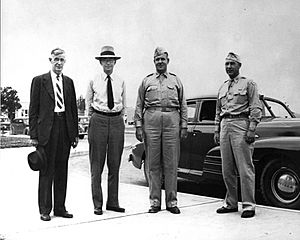
Bush met with President Roosevelt in October 1941. He told Roosevelt about the British atomic bomb project. He also mentioned what little was known about Germany's nuclear plans. Roosevelt approved and sped up the U.S. atomic program. Bush suggested the army run the project, not the navy.
In March 1942, Bush sent a report to Roosevelt. It outlined calculations for the size of an atomic bomb. It estimated a bomb could have the power of 2,000 tons of TNT. Bush pushed for more funding and faster progress.
Bush was not happy with how slowly the project was moving. He complained to top officials. As a result, Brigadier General Leslie R. Groves was appointed to lead the project in September. Groves quickly approved key sites and got top priority for the project. Bush also helped create a Military Policy Committee to guide the project.
Bush believed in working with the United Kingdom on the atomic bomb. After some disagreements, the Quebec Agreement merged the two projects. Bush was one of the U.S. representatives on the Combined Policy Committee.
Bush was part of the Interim Committee that advised President Harry S. Truman on nuclear weapons. This committee recommended using the atomic bomb against an industrial target in Japan. Bush was present at the Trinity nuclear test in July 1945. This was the first time an atomic bomb was detonated.
Post-War Ideas and Influence
After the war, Bush wrote an important essay called "As We May Think". It was published in July 1945. In it, he introduced the idea of the memex.
The Memex Concept
Bush imagined the memex as a device to help people remember and organize information. It would be a microfilm-based machine. It would store all of a person's books, records, and communications. It would let them find information very quickly and easily.
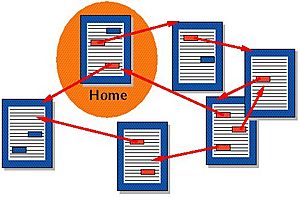
He wanted the memex to work like the human brain. It would link information by association, not just by indexes. He saw it as "an enlarged intimate supplement to his memory." He predicted "wholly new forms of encyclopedias" with "a mesh of associative trails running through them."
"As We May Think" greatly influenced later computer scientists. Douglas Engelbart read it and was inspired to invent the computer mouse. Ted Nelson, who created the terms "hypertext" and "hypermedia", also drew inspiration from Bush's vision.
Bush was worried about "information overload" for scientists. He predicted a time when researchers would be overwhelmed by too much information. His essay showed a way to manage this problem.
National Science Foundation
After the war, Bush wanted a new government agency to replace the OSRD. He believed that basic scientific research was vital for national security and economic growth. In his 1945 report to the president, Science, The Endless Frontier, he argued for continued government support for science.
Bush believed that "basic research was the pacemaker of technological progress." He said new products come from new ideas developed through pure science. He wanted government funding for physical and medical sciences.
There was a debate in Congress about how to set up this new agency. Bush wanted it controlled by a group of top scientists. President Truman disagreed with some of Bush's ideas. The OSRD was closed in December 1947 without a replacement.
The military stepped in to fill the gap. The Office of Naval Research (ONR) supported scientific research. Bush also helped create the Joint Research and Development Board (JRDB). This board promoted research through the military. Finally, in 1950, the National Science Foundation (NSF) was created. It was signed into law by President Truman.
Later Years and Legacy
Bush continued to serve on various panels and boards. In 1949, he helped a scientific panel confirm that the Soviet Union had tested its first atomic bomb. He also spoke out against the decision to remove Robert Oppenheimer's security clearance in 1954. Many scientists saw Bush as "the Grand Old Man of American science."
Bush retired as president of the Carnegie Institution in 1955. He continued to serve on company boards, including Merck & Co.. He was also a trustee for several universities and institutions.
Vannevar Bush died on June 28, 1974, at age 84. He was buried in South Dennis, Massachusetts. At a memorial service, Jerome Wiesner said, "No American has had greater influence in the growth of science and technology than Vannevar Bush."
Awards and Honors
- Bush received the Edison Medal in 1943 for his work in electrical engineering.
- In 1945, he was given the Public Welfare Medal from the National Academy of Sciences.
- President Truman awarded him the Medal of Merit in 1948.
- President Lyndon Johnson gave him the National Medal of Science in 1963.
- In 1970, President Richard Nixon presented him with the unique Atomic Pioneers Award.
- He was made a Knight Commander of the Order of the British Empire in 1948. He also received the French Legion of Honor in 1955.
In 1980, the National Science Foundation created the Vannevar Bush Award. This award honors his contributions to public service.
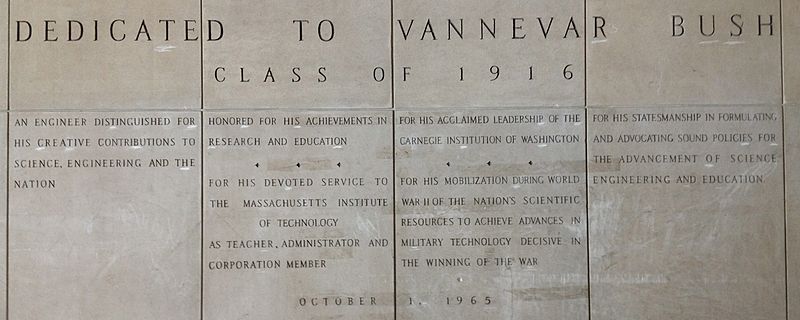
Images for kids
-
Bush attending a meeting at the University of California, Berkeley in 1940. From left to right: Ernest O. Lawrence, Arthur H. Compton, Bush, James B. Conant, Karl T. Compton, and Alfred L. Loomis.
-
A cut away diagram of the proximity fuze Mark 53.
-
Bush (left) with Harry S. Truman (center) and James B. Conant (right).
-
From left to right in a November 1969 photo, Dr. Glenn Seaborg, President Richard Nixon, and the three awardees of the Atomic Pioneers Award: Dr. Vannevar Bush, Dr. James B. Conant, and Gen. Leslie Groves.
See also
 In Spanish: Vannevar Bush para niños
In Spanish: Vannevar Bush para niños


